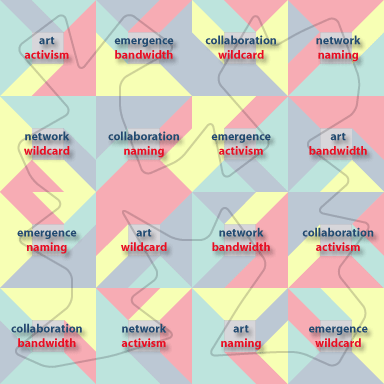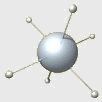The texts are structured by a Graeco-Latin Square of order 4, a combinatorial structure frequently used in agricultural test plots, typically for combining plant strains with different fertilizers in such a way that no plants or fertilizers are repeated in any row or column of the square. The order of texts was determined by random operations that preserve the properties of the square and keep the text numbered 16 in the last slot. The texts are read left to right across the square.
Plants: Network, Collaboration, Art, Emergence
Fertilizers: Activism, Bandwidth, Naming, Wildcard
In addition to sources cited in the text, I have paraphrased or loosely quoted Ted Nelson, Umberto Campagnolo, and Geert Lovink. John Cage's lectures, which flow from his compositional techniques and philosophy, are a clear inspiration.
Supplement, Paul Hertz, Chicago, 2003-05  1. Art / Activism: Technological progress can rather easily channel utopian desire, for both derive the meaning of individual actions from a teleological myth. If the realpolitik hidden behind technotopia appears ethically abhorrent, what strategies can artists working with technology adopt to combat it? I will boldly assert that investigation, analysis, criticism, and humor still work. These are the tools of culture in which we may retain at least a secular faith, even in this age of exhausted narratives. 1. Art / Activism: Technological progress can rather easily channel utopian desire, for both derive the meaning of individual actions from a teleological myth. If the realpolitik hidden behind technotopia appears ethically abhorrent, what strategies can artists working with technology adopt to combat it? I will boldly assert that investigation, analysis, criticism, and humor still work. These are the tools of culture in which we may retain at least a secular faith, even in this age of exhausted narratives.
2. Emergence / Bandwidth:Mark C. Taylor, in his book The Moment of Complexity: Emerging Network Culture, suggests that networks offer a organizational scheme radically unlike the rationalized grids and hierarchies that he sees prevailing from the Enlightenment through Modernism. The network is both substantive and emerging, a structure and a paradigm. Networking displaces the grid. Topology is destiny.
3. Collaboration / Wildcard: A number of licensing schemes exist to support collaborative development of software. These are variously known as free software, open source, or public license. Profit enters the picture through consulting, service, and support, not through sales. Anyone with the right skills can modify and improve free software -- but they can't sell it. On the other hand, they can contribute their improvements to the further development of the software. Collaboration is built into the economic model.
4. Network / Naming:I say "broadband" and you're likely to think of movies on demand. It's a commercial buzzword, but so is "Internet." According to Joel Mambretti, Director of the International Center for Advanced Internet Research, researchers are alarmed by how quickly mass entertainment media appropriate enabling technologies. With "Internet2" reduced to hype, research administrators have to scrap "Internet3." They cast about for new names to mark the territory, or stick with angular acronyms without a whiff of glamour.
5. Network / Wildcard:With spam and porn as the Internet's most egregious growth industries, the utopian bloom has faded from the Net. Though it was long suspected that culturally determined signs of identity and their attendant privileges, ironies, and afflictions were bound to persist in the virtual world, the vision of a world bound together by an emerging networked consciousness hovered over the future for one giddy moment. Whether technology could further humanity's collective voyage from effective mass illiteracy to critical thought and self-determination [Umberto Campognolo] seemed too serious a question then, but it is perhaps the only question still worth asking, now that the party is over.
6. Collaboration / Naming:Only a fraction of the world's people have a presence in cyberspace; the rest are outsiders. On the border between inside and outside, objects and persons acquire names; differences are constructed. When insiders and outsiders meet to collaborate, let them first exchange names. "Hello, we call this progress -- what is your name for it?"
7. Emergence / Activism:As networks become more densely intertwingled [Ted Nelson], what emerges may not be a new consciousness bootstrapping itself into existence, but new forms of social organization -- new ways of making decisions about our lives. If we sweep away the hype and mysticism about world-wide networks, we may even have cause for optimism.
8. Art / Bandwidth: So where should the ambitious artist set out to work with technology? Look to the frontier -- where the bandwidth breeds and the funding flows. Where the lonesome engineers have toys they haven't learned to play with. Where the audience is tiny but you'll eat.
9. Emergence / Naming:What emerges? A new consciousness? A new world order? Who will have the power to name emergent phenomena in world ecology, in human society? Is it our responsibility? If we don't name it, does it exist at all?
10. Art / Wildcard:
Let a thousand hybrids bloom. Against the nemesis of "das mediale Gesamtkunstwerk" [Geert Lovink], total/izing media art, let a thousand recombinants contend. Let resistant versions of the truth work in the interstices, wedge themselves intot he cracks in the media wall. Hybridity is not a choice, but the condition of survival.
11. Network / Bandwidth:In the beginning, the Internet was not designed for person-to-person communication. It also wasn't designed to withstand an atomic blast. Both concepts came later. First, computers talked to computers. Today, some of the new broadband technologies are still dedicated to machine-to-machine communications. In fact, most network traffic is machine-to-machine data exchange. Who needs bandwidth? The technology itself needs bandwidth. Let's grow some.
Juanita Miller, Point of Criticality  12. Collaboration / Activism: In contrast to forms of activist art where getting arrested validates the work (no publicity is bad publicity), consider the strategy of cultural animation. In this model, which borrows from the work of Paolo Freire, artists work within a community, getting to know people directly, understanding their circumstances firsthand. The artist may have to sacrifice autonomy and protagonism, but the work will be rooted in and emerge from the community. And yes -- you may still get arrested. 12. Collaboration / Activism: In contrast to forms of activist art where getting arrested validates the work (no publicity is bad publicity), consider the strategy of cultural animation. In this model, which borrows from the work of Paolo Freire, artists work within a community, getting to know people directly, understanding their circumstances firsthand. The artist may have to sacrifice autonomy and protagonism, but the work will be rooted in and emerge from the community. And yes -- you may still get arrested.
13. Collaboration / Bandwidth:Broadband communication technology makes the Internet as media feeding tube technically feasible -- indeed, likely -- but collaborative models of communications have not been entirely displaced by models of passive consumption. Collaborative models have already met with considerable success at the low end -- perhaps because megamedia isn't much interested in low bandwidth. If the economic barriers are low enough, medium bandwidth networks will also become a tool for building communities. At the high end, the issue may be how to keep collaborative models viable during the transition out of the lab, since they are at the frontier not just of technology, but of commodification.
14. Network / Activism:Coordinated worldwide protest against the latest war would not have been possible without the Internet. Primitive email and listserv technology gets things rolling. As events develop, tactical media steps in. Participants, not professionals, report on what's happening, with whatever bandwidth is available. Tactical media make no pretense of delivering non-partisan observation -- but at least they offer alternatives to the predigested cud of televised news.
15. Art / Naming: I lived in Spain during the transition from dictatorship to democracy, and had the privilege of participating as an observer, writing about events to friends in other countries. The criticism I most frequently heard being leveled against artists who wanted to be political activists -- though it was by no means confined to them -- was afan de protagonismo, the desire to be a protagonist; self-designated, of course. Naming is not enough, whether one is calling up the devil or seeking political change.
16. Emergence / Wildcard:From the Statistics of Deadly Quarrels, by Lewis Richardson, the following table of data. From the show Turbulent Landscapes -- at the San Francisco Exploratorium, 1995 -- Juanita Miller's sculpture Point of Criticality (http://www.exploratorium.edu/turbulent/exhibit/ criticality.html). Like the frequency and the number of deaths in wars, the frequency and size of avalanches in Miller's heap of corn obey a Power Law Distribution. Wars also obey the law of distribution of power. With careful study, avalanches can be avoided and their severity reduced.
| 1820 to 1945 |
|
|
| Number of Dead |
|
Number of Wars |
| 1000 |
|
188 |
| 10,000 |
|
63 |
| 100,000 |
|
24 |
| 1,000,000 |
|
5 |
| 10,000,000 |
|
2 |
Lewis Richardson, Statistics of Deadly Quarrels.
Cited in Axelrod & Cohen, Harnessing Complexity (Basic Books, 2000)
|

